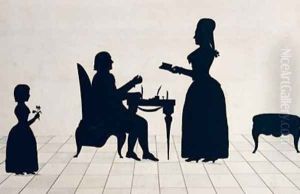Jean Gaspard Lavater Paintings
Jean Gaspard Lavater was a Swiss pastor, philosopher, writer, and poet, best known for his work in the field of physiognomy, the study of the connection between an individual's outer appearance, especially the face, and their character. Born on November 15, 1741, in Zurich, Switzerland, into a family with a rich history in the clergy, Lavater was drawn to theology and the human sciences from an early age. He pursued his education in his hometown, showing a keen interest in literature and philosophy alongside his theological studies. Lavater's intellectual curiosity was broad, encompassing poetry, ethics, and eventually physiognomy, which would become his life's work.
Lavater's most significant contribution to the arts and sciences was his work 'Essays on Physiognomy,' first published in 1775 and later expanded into several volumes. This work aimed to outline a systematic approach to judging a person's character based on their facial features. Lavater's ideas were influential, attracting the attention of notable figures across Europe, including Johann Wolfgang von Goethe, with whom Lavater formed a lasting friendship. Despite the skepticism of many contemporary scientists and philosophers who questioned the empirical basis of physiognomy, Lavater's theories were widely popular among the public and contributed to a broader discourse on the relationship between the physical and the spiritual, the body and the soul.
Throughout his life, Lavater was involved in various social and religious causes. He was a vocal critic of the radical changes brought about by the French Revolution, advocating for a more spiritual and moral form of governance. This stance, combined with his outspoken nature, eventually led to his arrest by French troops during their occupation of Zurich in 1799. Although released, Lavater was severely wounded in a later conflict and succumbed to his injuries on January 2, 1801.
Lavater's legacy is complex. While his work in physiognomy has largely been discredited by modern science for its lack of empirical support and potential for promoting stereotypes, his influence on the literature, art, and psychology of his time is undeniable. He remains a figure of fascination for historians and scholars interested in the Enlightenment and the interplay between science, philosophy, and religion in the late 18th century.

